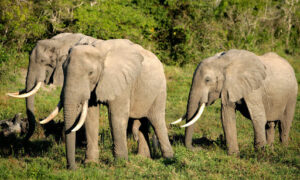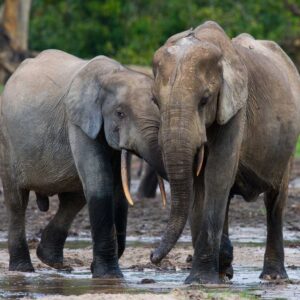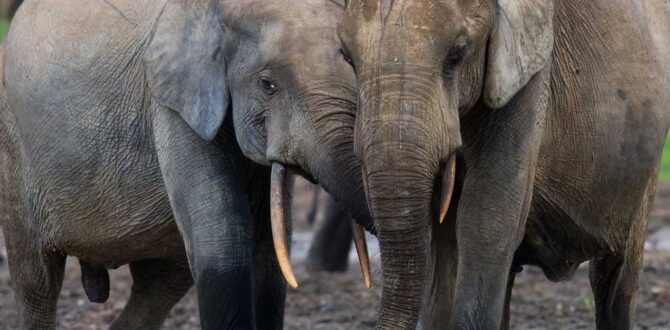By Ndimuh B. Shancho
_____________________
The Africa Forest Elephant (Loxodonta cyclotis), classified as Critically Endangered on the IUCN 2021 Red List, continues to compete with adjacent communities on resources in the Mount Cameroon National Park

The Mount Cameroon National Park is a 58,154-hectare IUCN Category II protected area created by the Cameroon Government in 2009. At creation, about 170 forest elephants were recorded. Official reports in 2019 indicate its population within the protected area now stands at 300.
On the other hand, the human population around the emblematic Park and its 41 adjacent villages also witnessed an exponential increase within the past five years. This is motivated by its rich volcanic soil and a hospitable climatic condition, a stable educational system at the University of Buea and most recently, the security challenges amidst an armed conflict that has caused migration of many.
The South West Regional Delegate in the Cameroon Ministry of Forestry and Wildlife, Delphine Ikome, says the increase in both elephant and human population in the Mount Cameroon Area has brought about competition for the same land and resources.
“Human elephant conflict is more evident today due to massive conversion of forested land for crop cultivation. Most of the areas, which elephants have memories of as feeding sites are now occupied by farmlands, houses, and plantations. When this wildlife species come to this forest-turned human habitat to feed, there is bound to be conflict,” she said.
Ugly Face of the Conflict
Bakingili of the West Coast Cluster conservation zone of the Mount Cameroon National Park and Bomana of the Bomboko Cluster are two communities that have come face-to-face with the ugly face of Human elephant conflict.

In Bakingili, over 200 villagers organized a march in September 2021 and protested against what they termed the unbearable destruction of crops and homes by the Africa forest elephant. According to the villagers, this species stormed the village in August and September 2021 and destroyed over 250 banana, plantain, corn, bean plantations and dozens of homes. A similar destruction was recorded in Bomana in October 2022.
In retaliation, the villagers in Bakingili reportedly killed two elephants and openly depicted negative attitudes towards elephant conservation. Farmers and villagers in both communities have been unanimous that the Government join them to kill the elephants to save their lives and property.
On the contrary, Government authorities blame locals for occupying elephant habitats, and have cautioned them against killing the animal listed as Category “A” in the Cameroon Forestry Law. According the 1994 Forestry Law, the maximum penalties for killing a protected species like the elephant are 3 years of imprisonment and/ or FCFA 10 Million.
Possibility of Human Elephant Co-existence?

According to the Conservator of the Mount Cameroon National Park, Charles-Innocent Memvi Abessolo, neither adjacent the community nor the elephants can be sent away. The Mount Cameroon National Park boss believes continuous funding to intermittently organize scaring missions where shooting is done in the air with fireworks will send elephants far into the forest. Also, creating pepper fence along the park borders and constantly refreshing the pepper, as well as bee fencing will also deter elephants from crossing the park borders to community farms.
Mr. Memvi Abessolo cautions communities against encroachment into the Park boundaries, underscoring the need for continuous community sensitization. He disclosed that the list of the August and September 2021 human-elephant conflict victims is being constituted for further supports.
Why Conserve Elephants?
Elephants have been described by many as great engineers within the ecosystem. Their dung facilitates the growth of many plants and tree species like the acacia trees, with some plants totally dependent on this large mammal for their dispersal. This poses the elephant as a key architect in the regeneration of the forest which serves as a carbon sink and is very instrumental in fighting climate change, one of the world’s most dreadful crises. Beside these, elephants play a crucial role in improving the conditions of other species in the forest.
The presence of elephants and other wildlife species serves as a great source of attraction for ecotourists. This has increased the GDPs of many countries in Africa and provided jobs for many. In 2017, ecotourism increased Uganda’s GDP by 7.3%, with up to 19% of all jobs in Namibia directly or indirectly linked to ecotourism. Thus, eliminating elephants undoubtedly poses both environmental and economic challenges.







